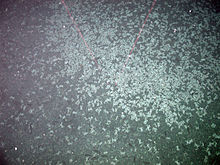Cyanagraea
Appearance
| Cyanagraea praedator | |
|---|---|

| |
| Scientific classification | |
| Kingdom: | |
| Phylum: | |
| Subphylum: | |
| Class: | |
| Order: | |
| Infraorder: | |
| Family: | |
| Genus: | Cyanagraea de Saint Laurent, 1984
|
| Species: | C. praedator
|
| Binomial name | |
| Cyanagraea praedator de Saint Laurent, 1984
| |
Cyanagraea praedator is a species of crab that lives on hydrothermal vents, and the only species in the genus Cyanagraea.[1][2]
It is found at depths of 2,535–2,630 m (8,317–8,629 ft) on the East Pacific Rise,[3] where it lives "in the upper part of black smoker chimneys".[4] Its haemocyanin has a strong affinity for oxygen, and displays a significant Bohr effect, which is unaffected by lactic acid.[5]
Cyanagraea praedator is "by far the largest" species in the family Bythograeidae, growing to a maximum carapace size of 123.0 mm × 74.8 mm (4.84 in × 2.94 in).[3]
The leech Bathybdella sawyeri has been observed attached to C. praedator.[6]
References
- ^ Peter Davie (2011). "Cyanagraea Saint Laurent, 1984". WoRMS. World Register of Marine Species. Retrieved November 27, 2011.
- ^ Peter K. L. Ng, Danièle Guinot & Peter J. F. Davie (2008). "Systema Brachyurorum: Part I. An annotated checklist of extant Brachyuran crabs of the world" (PDF). Raffles Bulletin of Zoology. 17: 1–286.
- ^ a b Colin McLay (2007). "New crabs from hydrothermal vents of the Kermadec Ridge submarine volcanoes, New Zealand: Gandalfus gen. nov. (Bythograeidae) and Xenograpsus (Varunidae) (Decapoda: Brachyura)" (PDF). Zootaxa. 1524: 1–22.
- ^ Fabienne Chausson, Christopher R. Bridges, Pierre-Marie Sarradin, Brian N. Green, Ricardo Riso, Jean-Claude Caprais & François H. Lallier (2001). "Structural and functional properties of hemocyanin from Cyanagraea praedator, a deep-sea hydrothermal vent crab". Proteins: Structure, Function, and Bioinformatics. 45 (4): 351–359. doi:10.1002/prot.10014. PMID 11746683.
{{cite journal}}: CS1 maint: multiple names: authors list (link) - ^ Stéphane Hourdez & François H. Lallier (2007). Ricardo Amils, Cynan Ellis-Evans & Helmut Hinghofer-Szalkay (ed.). "Life in Extreme Environments, Part II" (PDF). Reviews in Environmental Science and Biotechnology. 6 (1–3). Springer: 143–159 [297–313]. doi:10.1007/s11157-006-9110-3. ISBN 978-1-4020-6284-1.
{{cite journal}}:|chapter=ignored (help) - ^ Eugene M. Burreson & Michel Segonzac (2006). "Morphological variability of Bathybdella sawyeri (Hirudinida: Piscicolidae) from hydrothermal vents on the Galápagos Rift and the South East Pacific Rise" (PDF excerpt). Zootaxa. 1286: 15–21.
Further reading
- Michèle de Saint Laurent (1984). "Crustacès dècapods d'un site hydrothermal actif de la dorsale du Pacific oriental (13° Nord), en provenance de la campagne française Biocyatherm". Comptes Rendus de l'Académie des Sciences de Paris. sèrie III. 299: 355–360.
- Robert R. Hessler & Joel W. Martin (1989). "Austinograea williamsi, new genus, new species, a hydrothermal vent crab (Decapoda: Bythograeidae) from the Mariana Back-Arc Basin, Western Pacific". Journal of Crustacean Biology. 9 (4): 645–661. JSTOR 1548594.
External links
